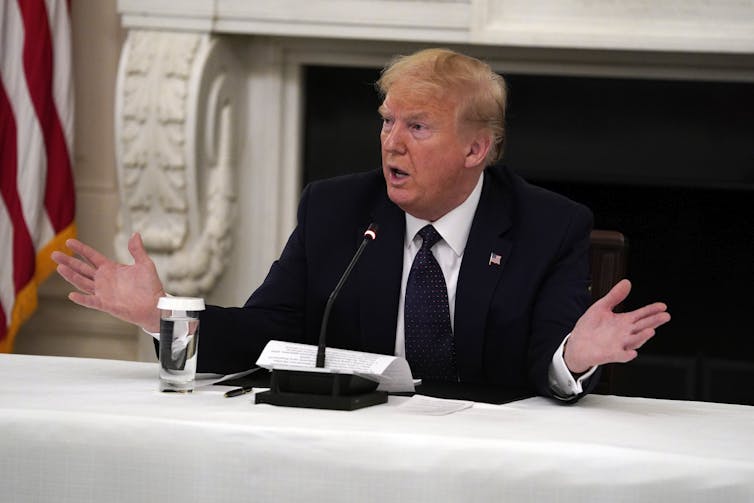When Trump pushed hydroxychloroquine to treat COVID-19, hundreds of thousands of prescriptions followed despite little evidence that it worked
- Written by Richard L. Kravitz, Professor of Health Policy and Internal Medicine, University of California, Davis
In late March and early April, President Trump repeatedly proclaimed that hydroxychloroquine[1] could prevent or treat COVID-19. Within days, the number of prescriptions for the drug skyrocketed even though evidence it could safely prevent or treat the disease was at the time very weak.
A casual remark by a president who is not in any way a medical expert somehow led thousands of U.S. physicians to write prescriptions for a drug that had never before been used to treat a viral illness. What could be happening here?
As a general internist[2] at the University of California, Davis health center, I have seen thousands of patients in both inpatient and outpatient settings. As a researcher, I have focused on how patients influence what physicians do[3], and consequently, I often find myself asking how the larger world influences what patients think.
Through my research, I’ve found that the process of prescribing medication is more complicated than most people realize. In the real world, it’s a mix of the current state of medical knowledge and a negotiation between what the patient wants or asks for and the habits and beliefs of the physician. It is a human experience, and can be influenced by things like advertising, media and even politics.
I think the hydroxychloroquine situation perfectly illustrates how much the outside world shapes patients’ views of their own health care. It also shows how, particularly when the science is uncertain, patients’ views strongly affect what their doctors do.
 President Trump has repeatedly and consistently touted the effectiveness of hydroxychloroquine despite shaky scientific evidence at best, even going so far as to announce that he was taking it as a preventative measure against the coronavirus.
AP Photo/Evan Vucci[4]
President Trump has repeatedly and consistently touted the effectiveness of hydroxychloroquine despite shaky scientific evidence at best, even going so far as to announce that he was taking it as a preventative measure against the coronavirus.
AP Photo/Evan Vucci[4]
The hydroxychloroquine boom
On March 21 President Trump touted hydroxychloroquine – and its biochemical cousin, chloroquine – as potential “game changers”[5] in the battle against COVID-19. Two months later, he announced on national television that he had been taking the drug himself[6] as a preventative treatment.
During the 10-week period between Feb. 17 and April 27 doctors wrote approximately 483,000 more prescriptions for hydroxychloroquine[7] than in the same time period in 2019. The week after President Trump mentioned the drug during a press conference, prescriptions were up more than 200% compared to the previous year[8]. The vast majority of excess prescriptions were written between March 14 and April 4, but as news spread about shortages of the drug and the lack of evidence to support its use, prescribing returned quickly to normal.
Research now shows that this once-promising drug likely isn’t effective for preventing or treating COVID 19[9], but the damage was already done. Hundreds of thousands of Americans unnecessarily took medicine that can have dangerous side effects[10]. Additionally, many people with an actual medical need to take hydroxychloroquine – like those living with lupus and related autoimmune diseases – found themselves unable to obtain the drugs they needed[11].
What explains the sharp rise, and equally precipitous fall, of hydroxychloroquine prescriptions?
Amplification of shaky science
The hydroxychloroquine story is in part connected to the way information about prescription drugs in the United States is produced and disseminated. This process greatly influences what the public thinks about drugs.
First, the clinical research supporting the use of hydroxychloroquine for COVID-19 was shaky from the start[12]. The initial studies were very small, and likely because of the pressure from the pandemic, the research was rushed through the usual safeguards like peer review[13].
[Get facts about coronavirus and the latest research. Sign up for The Conversation’s newsletter.[14]]
Second, influential individuals and organizations played on the public’s perceptions. President Trump was certainly a factor, but media outlets – notably Fox News[15] and the New York Post[16] oversold the apparent benefits and downplayed the ample uncertainty surrounding the treatment at the time. Even The New York Times may have inadvertently contributed to the initial prescribing stampede[17] by covering the science before it was peer–reviewed, even though they clearly stated the shortcomings of the research.
The truth is that researchers, academic institutions, medical journals and the media all face powerful incentives to portray the latest research findings as more earthshaking than they actually are. Under normal circumstances, numerous mechanisms exist to blunt some of the worst overhyping and many sources of medical information do their best to be accurate in what they report. But in the midst of a pandemic, the urgency of the moment can overwhelm these defenses and good intentions. Bad science can be spread far and wide by normally credible sources.
 Why were doctors prescribing hydroxychloroquine to patients when the science was still so shaky?
LWA-Dann Tardif / Stone via Getty Images[18]
Why were doctors prescribing hydroxychloroquine to patients when the science was still so shaky?
LWA-Dann Tardif / Stone via Getty Images[18]
From public interest to actual prescriptions
It would be one thing if patients could get unproven medications like hydroxychloroquine for COVID-19 on their own. But physicians are supposed to be the guardians at the gate of medicine. Why were doctors writing prescriptions for a drug to fight COVID-19 without evidence that it worked?
Some physicians were likely overeager early adopters. Additionally, some hospitals – including my own at the University of California, Davis – made hydroxychloroquine available to COVID-19-positive inpatients during the early days of the epidemic. However, early adopters constitute a low percentage of all prescribers - generally less than 10% according to one study[19] – and cumulative U.S. hospitalizations through April 25 totaled no more than 150,000[20]. With almost a half million extra prescriptions filled over that time, these explanations cannot fully explain the surge.
Substantial research, including my own, shows that when patients ask for drugs by name, doctors will frequently prescribe them[21]. A reasonable hypothesis is that many of the excess hydroxychloroquine prescriptions filled in the weeks after President Trump’s remarks resulted from patients asking about or explicitly requesting hydroxychloroquine from their primary care physicians.
Over a decade ago, my colleagues and I ran an experiment where we sent actors pretending to have symptoms of depression to see physicians. Some of the actors explicitly asked for drugs while others did not. The results were striking. Patients requesting antidepressants were more than twice as likely to receive them[22], regardless of whether their symptoms warranted the drugs or not.
These results should not be overinterpreted - we would not have found the same results in a study where patients with broken bones asked for chemotherapy, for example. But much of medical practice occurs in the gray zone of limited evidence. It is these gray areas where media and advertising most influence patients[23], who in turn influence physicians. With research on treatments for COVID-19 coming out at an incredible rate, the health effects of the virus still largely a mystery and people’s lives on the line, the gray zone for COVID-19 treatments is massive.
In the case of hydroxychloroquine, the combination of shaky science, loud public proponents like the president and the influence patients have on physicians likely resulted in close to half a million prescriptions before the public health benefits and risks were adequately understood.
Research on hydroxychloroquine has accumulated, and now most experts agree that it likely isn’t effective[24] as a COVID-19 treatment – with some studies even suggesting that it may be harmful[25]. But new drugs and treatments to fight this deadly virus are going to continue to emerge in the coming months and years. The media, politicians, doctors and patients must all maintain a critical stance and acknowledge the influence they have on each other.
Waiting for solid evidence in the form of randomized studies takes patience. But the alternative is to wander into a therapeutic fog where potential harms lurk alongside potential benefits. This is never a good idea, and it is especially dangerous now.
References
- ^ President Trump repeatedly proclaimed that hydroxychloroquine (www.huffpost.com)
- ^ general internist (health.ucdavis.edu)
- ^ patients influence what physicians do (scholar.google.com)
- ^ AP Photo/Evan Vucci (www.apimages.com)
- ^ potential “game changers” (thehill.com)
- ^ taking the drug himself (thehill.com)
- ^ 483,000 more prescriptions for hydroxychloroquine (dx.doi.org)
- ^ 200% compared to the previous year (dx.doi.org)
- ^ isn’t effective for preventing or treating COVID 19 (theconversation.com)
- ^ can have dangerous side effects (www.who.int)
- ^ unable to obtain the drugs they needed (www.washingtonpost.com)
- ^ shaky from the start (theconversation.com)
- ^ rushed through the usual safeguards like peer review (theconversation.com)
- ^ Sign up for The Conversation’s newsletter. (theconversation.com)
- ^ Fox News (www.foxnews.com)
- ^ the New York Post (nypost.com)
- ^ initial prescribing stampede (www.nytimes.com)
- ^ LWA-Dann Tardif / Stone via Getty Images (www.gettyimages.com)
- ^ less than 10% according to one study (www.jstor.org)
- ^ no more than 150,000 (gis.cdc.gov)
- ^ doctors will frequently prescribe them (dx.doi.org)
- ^ twice as likely to receive them (dx.doi.org)
- ^ media and advertising most influence patients (doi.org)
- ^ it likely isn’t effective (theconversation.com)
- ^ may be harmful (dx.doi.org)
Authors: Richard L. Kravitz, Professor of Health Policy and Internal Medicine, University of California, Davis

